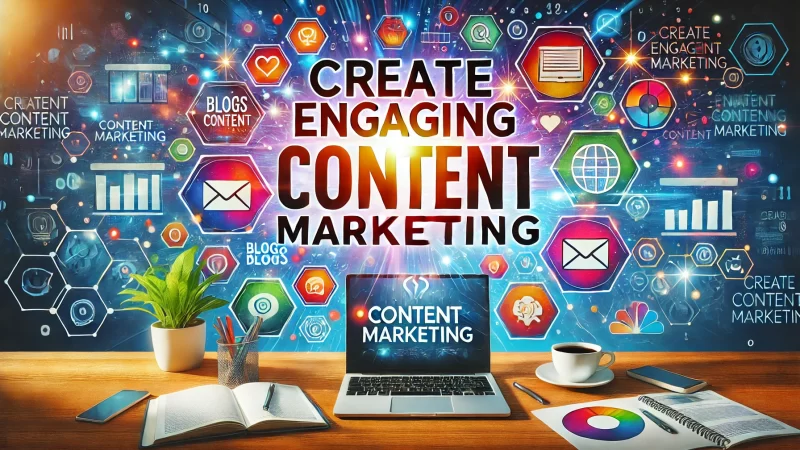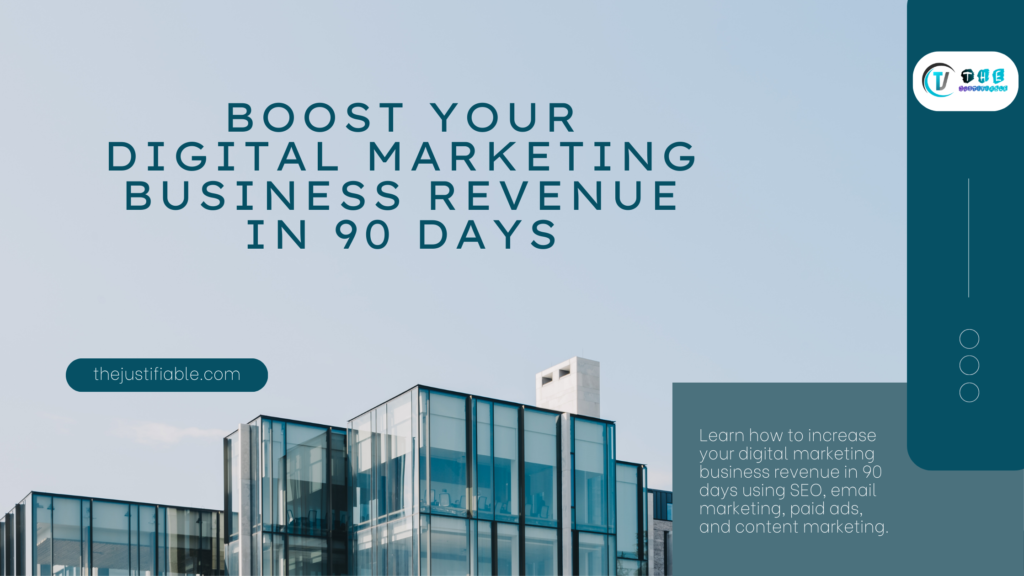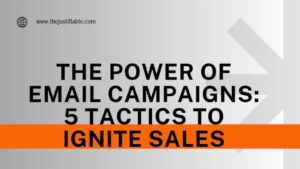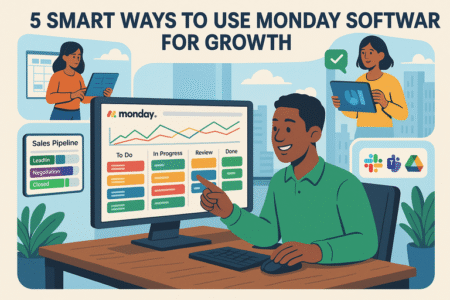Table of Contents
Are you ready to boost your digital marketing business revenue in 90 days? As a beginner in the world of online marketing, it can be overwhelming trying to figure out where to start. Should you focus on SEO, or is paid advertising a quicker route to success? How do you measure your progress? The good news is that with the right strategies in place, you can start seeing tangible results faster than you might think.
In this article, you’ll discover the top strategies to help your digital marketing business grow. From setting clear revenue goals to optimizing your SEO, email marketing, and paid ads, these tactics will set you up for success. The best part? These are all beginner-friendly, actionable steps that can make a big difference in your bottom line. Let’s dive into how you can transform your business in just 90 days.
Why Digital Marketing Can Transform Your Business Revenue
Digital marketing has revolutionized how businesses operate, offering incredible opportunities for beginners to achieve rapid growth. With the right digital tools, even small businesses can compete with larger brands. I believe digital marketing opens doors for anyone to engage with a global audience, drive traffic, and boost sales efficiently. It’s a game-changer.
For businesses looking to boost their revenue quickly, digital marketing provides measurable and scalable strategies. I find that through data-driven tactics like SEO, content marketing, and paid ads, entrepreneurs can see what works and adjust accordingly. The ability to track every click and conversion gives marketers control over their business’s future success.
The Power Of Digital Tools For New Entrepreneurs
Digital tools level the playing field for entrepreneurs by providing access to resources previously reserved for large companies. I recommend tools like Google Analytics and SEO software that allow beginners to monitor and improve performance. These tools provide insights into customer behavior, which helps refine marketing strategies for better results over time.
Email marketing platforms like Mailmunch or ConvertKit can also help you connect with your audience. I’ve noticed that when you automate communication, you save time while improving engagement. Personalized emails are particularly effective at retaining customers, boosting sales by as much as 20%. It’s a tool no entrepreneur should overlook.
Social media management platforms like Hootsuite simplify content distribution. I suggest leveraging them to manage multiple channels at once, ensuring consistent messaging across all platforms. You’ll build brand awareness while saving time, all while staying engaged with your audience. Social media tools empower you to grow efficiently, even with limited resources.
Content creation tools like Canva or Adobe Spark make it easy to produce eye-catching designs without a graphic designer. I’ve learned that visually appealing content grabs attention and boosts click-through rates. These tools are user-friendly, perfect for entrepreneurs looking to maintain a professional image without the cost of hiring help.
Finally, I advise beginners to explore SEO tools like SEMrush to stay competitive in search rankings. SEO takes time but is one of the most powerful ways to drive organic traffic to your website. By optimizing for search engines, you can consistently attract qualified leads, increasing your business’s revenue potential.
How To Take Control Of Your Marketing Spend
One of the biggest advantages of digital marketing is the control it gives you over your marketing budget. I suggest setting clear limits on ad spend while consistently measuring your ROI. With platforms like Google Ads, you can adjust your budget in real-time based on performance, ensuring your dollars are working hard for you.
I’ve found that monitoring your ad performance regularly is key to maximizing ROI. Use analytics tools to track which ads convert best, and shift your spending towards what works. This will prevent wasteful spending on low-performing campaigns and direct your budget to areas that will drive the most revenue growth.
Many businesses make the mistake of thinking they need to spend big to see results. I believe that by starting with small, targeted campaigns, you can test the waters before scaling up. This allows you to gather data and refine your strategy without overspending, saving you time and money in the long run.
I recommend allocating a portion of your budget to retargeting ads. Retargeting allows you to reach users who’ve previously visited your site but didn’t convert. These ads are generally more cost-effective and yield higher conversion rates, making them a smart choice for maximizing your marketing spend.
I also suggest diversifying your ad spend across different channels. For example, running ads on both Facebook and Google can help you reach a broader audience. I’ve noticed that testing multiple platforms allows you to identify which ones are driving the highest return, enabling you to reallocate funds for optimal results.
Set Clear Revenue Goals For Your Digital Marketing Success
Setting revenue goals is essential to guide your digital marketing efforts in the right direction. Without clear objectives, you may find yourself investing time and money without knowing if it’s paying off. I advise starting with specific, measurable goals, ensuring that every marketing move you make contributes to revenue growth.

Clear goals provide a roadmap for success. By knowing what you’re aiming for, you can tailor your marketing strategies to hit those targets. I believe that goal-setting keeps you focused, helping you prioritize tactics like SEO or paid ads that will have the biggest impact on your revenue.
Importance Of Defining SMART Goals
SMART goals (Specific, Measurable, Achievable, Relevant, Time-bound) are a must for digital marketing success. I’ve learned that vague goals like “increase sales” don’t provide enough direction. Instead, setting a goal like “increase website traffic by 30% in 90 days” gives you a clear target and timeframe to work towards.
When your goals are measurable, it’s easier to track progress and adjust strategies accordingly. I recommend using tools like Google Analytics to measure key performance indicators (KPIs) like conversions, traffic, or engagement. These metrics will help you evaluate whether you’re on track to meet your revenue goals.
Achievable goals are critical to maintaining motivation. I’ve noticed that setting overly ambitious goals can lead to frustration and burnout. While it’s important to aim high, ensure that your goals are realistic based on your current resources and capabilities. This way, you’ll stay energized as you move towards success.
I suggest aligning your goals with your overall business vision. If your business aims to expand its customer base, your marketing goals should focus on lead generation and brand awareness. This alignment ensures that all marketing activities are driving towards long-term business growth, not just short-term wins.
Time-bound goals create urgency, motivating you to take action. I recommend breaking down larger goals into smaller milestones. For instance, aiming for a 10% increase in traffic each month will make your 90-day goal of 30% seem more attainable. These short-term wins build momentum and keep you moving forward.
How To Align Marketing Goals With Your Business Vision
To align marketing goals with your broader business vision, start by identifying your company’s core mission. I find that when your marketing goals reflect your values, your messaging becomes more authentic. This builds trust with your audience, leading to stronger brand loyalty and higher conversion rates over time.
It’s crucial to understand your target audience when setting marketing goals. I suggest creating buyer personas that reflect your ideal customer’s needs, desires, and pain points. By doing so, you can craft more targeted campaigns that resonate with your audience and drive higher engagement, aligning your marketing with your business objectives.
Consistency in messaging is key. I’ve noticed that businesses that maintain a consistent tone across all marketing channels are more successful in building a recognizable brand. Make sure your marketing goals include maintaining brand consistency, whether you’re posting on social media, sending emails, or creating blog content.
I recommend setting goals that push your business towards growth, rather than just maintenance. For example, instead of aiming to retain existing customers, set a goal to acquire a specific number of new leads each quarter. This proactive approach helps ensure your marketing efforts contribute to both short-term and long-term revenue increases.
Finally, I advise aligning marketing goals with customer feedback. Listen to what your customers are saying and use that data to adjust your marketing approach. Whether it’s through surveys, reviews, or social media interactions, customer feedback can provide valuable insights that refine your marketing strategy to better meet their needs.
Develop A Powerful SEO Strategy To Increase Organic Traffic
Developing a strong SEO strategy is crucial to driving long-term organic traffic. I suggest focusing on foundational SEO techniques like keyword research, on-page optimization, and quality content creation. These efforts help your website rank higher on search engines, making it easier for potential customers to find your business without paying for ads.
I’ve found that increasing organic traffic requires consistency and attention to detail. By optimizing your site’s structure, speed, and mobile experience, you provide a better user experience, which is favored by search engines like Google. These improvements help you grow your digital marketing business and increase revenue steadily.
SEO For Beginners: Understanding The Basics
SEO, or search engine optimization, is all about making your website more attractive to search engines. I recommend starting with keyword research. Identify terms your target audience searches for and incorporate those keywords naturally into your site’s content. This practice improves visibility and helps your pages rank higher in search results.
I’ve noticed that on-page SEO can make a huge difference in your site’s performance. I suggest optimizing your meta titles, descriptions, and headers to include your primary keywords. This helps search engines understand what your content is about, improving your chances of ranking higher for those terms.
Technical SEO is another important factor. Ensure your website loads quickly, is mobile-friendly, and has an organized structure. These elements are critical for both user experience and search engine rankings. I believe that even small technical improvements can have a big impact on your site’s overall performance.
Backlinks, or links from other websites to your site, also help improve SEO. I suggest reaching out to industry-related websites for guest blogging opportunities or partnerships. When reputable sites link back to your content, it boosts your site’s authority and improves your rankings.
Lastly, I advise tracking your SEO performance. Tools like Google Search Console and Serpstat WW allow you to monitor your site’s rankings, traffic, and keywords. By regularly analyzing your data, you can identify areas for improvement and adjust your SEO strategy to drive even more organic traffic.
How To Optimize Your Website For Higher Search Rankings
Website optimization is key to ranking higher in search engine results. I recommend starting with user experience—make sure your site is easy to navigate, loads quickly, and works well on mobile devices. Google rewards sites that offer a smooth experience, pushing them higher in search results and driving more traffic.
Next, focus on keyword optimization. I suggest including your primary keyword in your page titles, meta descriptions, and throughout your content. This helps search engines recognize the relevance of your content to users’ search queries, improving your chances of ranking higher for those terms.
Optimizing images can also boost your rankings. I advise compressing your images to reduce page load times, and adding descriptive alt text that includes relevant keywords. These actions enhance your site’s SEO and ensure a better user experience, which search engines take into account when ranking pages.
Another way to optimize is by improving internal linking. I recommend linking related pages within your site to help users find additional content and keep them on your site longer. This also helps search engines understand the structure of your site and boosts the SEO performance of linked pages.
Finally, I suggest using structured data (schema markup) to help search engines understand your content better. Structured data provides additional context to search engines, potentially leading to enhanced search results like rich snippets. This can significantly increase your site’s visibility and click-through rate.
Focus On Content Optimization To Drive Results
Content optimization is one of the most effective ways to boost your site’s rankings and drive more traffic. I suggest conducting keyword research to find terms your audience is searching for, and then incorporating those keywords naturally into your content. This helps search engines match your content with relevant user queries.
It’s important to create content that’s both informative and engaging. I find that when you write for your audience first, and search engines second, you’re more likely to keep readers on your page. Longer dwell times signal to search engines that your content is valuable, which can improve your rankings over time.
I also recommend regularly updating your content. Fresh content shows search engines that your site is active and relevant. I’ve seen businesses improve their SEO performance by revisiting older blog posts, adding new information, and optimizing for new keywords. This simple strategy can help boost rankings quickly.
Make sure to use multimedia elements like images, videos, and infographics to make your content more engaging. I’ve noticed that pages with visual elements tend to have lower bounce rates, which improves SEO. Plus, search engines reward websites that offer a rich user experience, leading to higher rankings.
Lastly, I suggest using call-to-actions (CTAs) strategically within your content. Encouraging readers to take the next step, whether it’s signing up for a newsletter or exploring other pages on your site, keeps users engaged and increases conversions. Engaged users signal value to search engines, further boosting your site’s performance.
The Role Of Backlinks In Boosting SEO Performance
Backlinks are critical to SEO success because they signal authority and trustworthiness to search engines. I suggest reaching out to industry influencers, guest posting on reputable sites, or partnering with other businesses to earn high-quality backlinks. The more authoritative the website linking to you, the more it can improve your rankings.
I find that creating shareable content like infographics, data reports, or valuable resources can naturally attract backlinks. When other sites see value in your content, they’ll link to it without you even asking. This organic link-building strategy is effective and helps improve your site’s domain authority.
Another strategy I recommend is fixing broken links. Find websites in your industry with broken outbound links and offer them your content as a replacement. This provides value to the site owner while securing a backlink for you. It’s a simple win-win situation that improves your SEO without much effort.
I also suggest participating in online communities or forums. By sharing your expertise and including a link back to your site where relevant, you can earn backlinks from trusted sources. This helps boost your site’s visibility and increases the chances of being found by search engines.
Lastly, I advise monitoring your backlink profile regularly. Tools like Ahrefs or SEMrush allow you to see who’s linking to your site and whether those links are helping or hurting your SEO. Regularly auditing your backlinks ensures you maintain a healthy, authoritative profile that supports your SEO goals.
Create Engaging Content Marketing That Drives Sales
Effective content marketing can transform your digital marketing business. I recommend focusing on creating high-quality, relevant content that resonates with your target audience. When you provide value through content, you build trust with your audience, leading to stronger relationships, more engagement, and ultimately, higher sales.

Content marketing isn’t just about writing blog posts. I believe it’s about delivering consistent, targeted messages across various platforms. Whether through articles, videos, or social media, each piece of content should serve your larger goal of driving sales. The key is to create content that addresses your audience’s pain points and needs.
How To Plan A Content Calendar That Supports Business Growth
Planning a content calendar is crucial for keeping your marketing efforts organized and consistent. I suggest starting by mapping out the types of content that align with your business goals. Whether it’s blog posts, videos, or social media updates, your content should drive towards building your brand and increasing revenue.
I recommend researching your audience’s needs and creating content that answers their questions or solves their problems. This not only keeps your audience engaged but also establishes you as an authority in your field. I’ve found that when your content is valuable, people are more likely to share it, expanding your reach.
Consistency is key when it comes to content marketing. I advise posting regularly, whether it’s weekly blog updates or daily social media posts. This helps keep your audience engaged and improves your visibility on platforms like Google and social media, where algorithms reward consistent activity.
I also suggest incorporating seasonal trends or events into your content calendar. For example, if you run a retail business, creating holiday-related content can drive traffic during peak shopping seasons. This not only keeps your content fresh but also positions your business to take advantage of timely opportunities.
Finally, I recommend reviewing your content calendar periodically to make adjustments based on performance. If certain types of content are driving more engagement or conversions, consider shifting your focus. A flexible content calendar allows you to adapt to what’s working and keeps your marketing efforts effective.
Types Of Content That Convert: Blogs, Videos, And Infographics
Different types of content appeal to different audiences. I suggest experimenting with a mix of blogs, videos, and infographics to see what resonates with your audience. Blogs are great for detailed, informative content that helps answer common questions, while videos and infographics provide a more engaging, visual experience.
I’ve noticed that blog posts are particularly effective for SEO. By focusing on long-form content optimized with relevant keywords, you can improve your search rankings while providing valuable information. I suggest writing blog posts that address common pain points or questions in your industry to attract more organic traffic.
Videos are becoming increasingly popular and can be a powerful tool for driving engagement. I recommend creating short, informative videos that highlight your products, services, or expertise. Videos often have higher engagement rates than written content, and they can be easily shared across multiple platforms.
Infographics are another effective way to communicate complex information in a visually appealing format. I’ve found that infographics are highly shareable and can help you build backlinks, boosting your SEO. I suggest creating infographics around topics your audience is interested in, making the content both informative and engaging.
I also recommend repurposing content. For instance, you can turn a blog post into a video or infographic to reach different segments of your audience. This allows you to maximize the value of each piece of content and increase its impact across various platforms.
Promoting Your Content Effectively To Reach New Audiences
Creating great content is only half the battle—you also need to promote it effectively. I suggest using social media platforms to share your content and reach new audiences. Platforms like Facebook, Twitter, and LinkedIn allow you to connect with different demographics, expanding your reach beyond your immediate audience.
I also recommend email marketing as a tool to promote your content. By sending out newsletters or content updates to your email list, you can keep your audience engaged and encourage them to share your content. This direct form of communication helps build stronger relationships with your audience.
Another effective promotion strategy is leveraging partnerships. I suggest collaborating with influencers, bloggers, or other businesses in your industry to share each other’s content. This exposes your content to a wider audience, boosting visibility and driving more traffic to your site.
Paid advertising can also be a useful tool for promoting content. I advise using platforms like Google Ads or Facebook Ads to target specific audiences. By promoting your content through paid ads, you can reach people who may not have otherwise discovered your business.
Lastly, I suggest promoting your content through guest blogging. Writing for other websites in your industry gives you the opportunity to share your expertise and link back to your own content. This not only boosts your credibility but also drives traffic from new sources, expanding your audience.
Leverage Paid Advertising To Accelerate Results In 90 Days
Paid advertising is a powerful way to drive immediate traffic and increase revenue. I suggest incorporating paid ads into your digital marketing strategy to see faster results, especially if you’re looking to boost your business within a short timeframe. Paid ads allow you to reach your target audience quickly and effectively.

With the right targeting and strategy, I’ve seen businesses increase their traffic and conversions significantly in just a few weeks. Paid advertising can be tailored to your budget, and platforms like Google and Facebook offer tools to track and refine your campaigns. This flexibility ensures you get the most out of your investment.
Introduction To PPC: Boosting Traffic With Paid Ads
PPC (Pay-Per-Click) is one of the most effective ways to drive immediate traffic to your website. I suggest using PPC if you want quick results. You only pay when someone clicks on your ad, ensuring that your budget is spent efficiently while directly boosting your site’s traffic and engagement.
The beauty of PPC is its ability to target specific audiences. I’ve found that by narrowing your audience based on location, interests, or demographics, you can increase the chances of converting visitors into customers. This ensures that your ads are being seen by the people most likely to engage with your business.
You can also control your ad spend with PPC. Platforms like Google Ads allow you to set daily or monthly budgets, preventing overspending. I recommend starting with a small budget to test different campaigns. Once you see which ads perform best, you can allocate more money towards the ones generating the highest returns.
Another benefit of PPC is its measurability. I advise using Google Analytics to track the performance of your PPC campaigns. You can see exactly which ads are driving traffic, how long users stay on your site, and which keywords lead to conversions. This data helps you adjust your strategy and improve future campaigns.
Lastly, I suggest optimizing your landing pages. Even the best PPC ad won’t convert if the landing page isn’t user-friendly or doesn’t match the ad’s messaging. Ensure your landing page has a clear call-to-action and relevant content to convert visitors into leads or sales once they click through.
How To Set Up Effective Facebook And Google Ads Campaigns
Setting up effective Facebook and Google Ads campaigns requires strategy and precision. I recommend starting by identifying your target audience. Both platforms offer robust targeting tools that allow you to reach the right people based on interests, demographics, and online behavior, increasing your chances of conversion.
Next, I suggest creating compelling ad copy and visuals. Whether it’s a Facebook carousel ad or a Google search ad, make sure your copy speaks directly to your audience’s needs and desires. I’ve seen that ads with strong, clear headlines and attractive visuals tend to perform better and generate higher click-through rates.
Don’t forget to use A/B testing. I advise testing multiple versions of your ads with slight variations in copy, images, or targeting. This allows you to see which ads perform best and helps you optimize your campaign for maximum effectiveness. Small tweaks can lead to big improvements in ad performance.
Budget allocation is another key factor. I recommend starting with a modest budget and gradually increasing it as you see which ads generate the best results. Both Facebook and Google allow you to set daily or lifetime budgets, helping you control costs while driving traffic to your site.
Finally, I suggest monitoring and refining your campaigns. Use the analytics tools on both platforms to track metrics such as click-through rates (CTR), cost-per-click (CPC), and conversions. This data provides insights into what’s working and what needs adjustment, ensuring your campaigns stay profitable.
Analyzing Your Paid Ad Performance For Maximum ROI
To maximize your return on investment (ROI), analyzing your ad performance is crucial. I recommend using platform-specific tools like Google Ads and Facebook Ads Manager to track how your ads are performing. Metrics like CTR and conversion rate can tell you which campaigns are driving traffic and sales effectively.
One key metric I advise focusing on is your cost-per-acquisition (CPA). This tells you how much it costs to acquire a customer from a specific ad campaign. By lowering your CPA through better targeting and ad optimization, you can increase your ROI without needing to increase your overall ad spend.
I also suggest looking at your ad frequency. Showing your ads too often can lead to ad fatigue, where users become annoyed by seeing the same ad repeatedly. I’ve found that adjusting the frequency ensures your ads remain fresh and relevant, preventing users from tuning out and improving your campaign’s effectiveness.
I advise comparing your results to industry benchmarks. Knowing how your ads perform relative to others in your industry gives you a clear idea of where you stand. If your CTR or conversion rate is below average, it’s a sign that you need to revisit your strategy and make improvements.
Lastly, I recommend using retargeting ads to re-engage visitors who didn’t convert on their first visit. These ads are highly effective because they target people who have already shown interest in your business. By focusing on these warm leads, you can improve your ROI and drive more conversions with less effort.
Budgeting For Paid Ads Without Overspending
When it comes to budgeting for paid ads, I suggest starting small and scaling up as you see results. Set a daily or monthly budget that you’re comfortable with, and closely monitor your campaigns. I’ve found that testing ads with a smaller budget helps prevent overspending while still gathering useful data.
One technique I recommend is to allocate more budget to high-performing ads. As you track your ad performance, you’ll notice which ads are driving traffic and conversions. I suggest shifting more of your budget towards these successful campaigns while cutting back on ads that aren’t performing as well.
I advise using a bidding strategy that aligns with your goals. Platforms like Google Ads offer various bidding options, such as cost-per-click (CPC) or cost-per-impression (CPM). I recommend experimenting with different strategies to see which one gives you the best results without overshooting your budget.
It’s also important to avoid ad fatigue by rotating your ads. I recommend refreshing your ad copy, visuals, or targeting criteria every few weeks. This prevents your audience from becoming bored with your ads, ensuring that they continue to engage with your content without needing to increase your budget.
Lastly, I suggest setting up spending limits on your campaigns. Platforms like Facebook and Google allow you to set hard caps on your daily or monthly spending. This ensures you won’t accidentally overspend, keeping your ad budget under control while still driving the results you need.
Harness The Power Of Email Marketing For Customer Retention
Email marketing is a powerful tool for keeping your customers engaged and driving repeat business. I suggest using email campaigns to nurture your relationship with existing customers, offering them valuable content and personalized offers. Well-crafted emails can help you maintain customer loyalty and boost your revenue over time.

By building a consistent email strategy, I’ve noticed that businesses can retain more customers and increase their lifetime value. Email allows you to stay top-of-mind with your audience, providing them with regular updates, promotions, or educational content. This keeps them engaged and encourages repeat purchases.
Crafting Email Campaigns That Speak To Your Audience
When crafting email campaigns, I recommend personalizing your content to speak directly to your audience. Start by segmenting your email list based on factors like purchase history or interests. This allows you to send targeted messages that resonate more deeply with each segment, increasing your chances of engagement.
Your email subject line is crucial. I suggest writing a compelling, attention-grabbing subject line that encourages recipients to open the email. Use power words that create a sense of urgency or highlight the value of your offer. A strong subject line can significantly boost your open rates and engagement.
I also recommend focusing on the body content of your email. Keep your message concise, and ensure that it provides value to the reader. Whether it’s offering a special promotion or sharing helpful tips, I’ve found that valuable content is more likely to convert readers into repeat customers.
Make sure to include a clear call-to-action (CTA) in every email. I suggest using one strong CTA per email, directing readers to take a specific action like visiting your website, making a purchase, or signing up for an event. A well-placed CTA drives conversions and increases the overall effectiveness of your email campaigns.
Lastly, I advise testing your emails before sending them. Use A/B testing to experiment with different subject lines, layouts, or CTAs. Testing allows you to see what works best with your audience, ensuring that each campaign performs optimally and delivers the results you’re aiming for.
How To Build A High-Converting Email List From Scratch
Building an email list from scratch takes time, but I’ve found that it’s one of the most valuable assets for your business. I suggest offering something of value in exchange for email signups, such as a free e-book, discount, or exclusive content. This gives users an incentive to join your list and keeps them engaged.
Make it easy for visitors to sign up. I recommend placing opt-in forms in multiple locations on your website, such as in the header, footer, and blog posts. A well-placed signup form can dramatically increase the number of people joining your list, helping you build your audience faster.
I also suggest promoting your email list on social media. You can encourage your followers to sign up for exclusive content, offers, or news by sharing posts or running ads. Social media can be an excellent way to attract more subscribers and grow your list quickly.
Partnering with other businesses or influencers is another great way to build your list. I advise collaborating on giveaways or content promotions where both parties benefit. You can tap into each other’s audiences to grow your lists and increase brand awareness at the same time.
Lastly, ensure that your emails comply with privacy regulations like GDPR. I recommend always getting explicit consent from users before adding them to your list. This builds trust and ensures that your subscribers are genuinely interested in receiving your emails, leading to higher engagement rates.
Personalization Techniques That Improve Engagement
Personalization is key to improving email engagement. I suggest using your subscribers’ names in the subject line or greeting to make your emails feel more personal. This simple touch can make a significant difference in open and click-through rates, as personalized emails feel more relevant and engaging.
Segment your list based on user behavior. I’ve found that sending targeted emails based on past purchases or interactions with your site leads to higher engagement. For example, you can send product recommendations based on what a user has bought before, creating a personalized experience that drives more sales.
Another technique I recommend is sending personalized offers. For instance, offering a discount on a customer’s birthday or anniversary with your brand can create a stronger connection. I’ve seen businesses achieve higher conversion rates with personalized offers that make customers feel valued and appreciated.
You can also personalize the timing of your emails. I suggest analyzing your audience’s behavior to determine the best times to send emails. By sending messages when your subscribers are most likely to check their inbox, you increase the chances of engagement and conversions.
Lastly, I advise using dynamic content in your emails. This allows you to show different content to different subscribers based on their preferences. For example, showcasing products relevant to each user’s interests can significantly boost engagement and lead to more personalized interactions with your brand.
Tracking And Optimizing Email Campaigns For Greater Success
To ensure your email campaigns are effective, I recommend tracking key performance metrics like open rates, click-through rates, and conversion rates. These metrics give you insight into how well your emails are performing and what areas need improvement. I’ve found that regularly reviewing this data helps optimize future campaigns.
A/B testing is a valuable tool for improving your email campaigns. I suggest testing different elements, such as subject lines, email copy, or images, to see which version performs better. Small changes can have a big impact on engagement, so it’s worth experimenting to find what resonates best with your audience.
You should also analyze your unsubscribe rate. I advise paying attention to when and why people are unsubscribing from your list. If your unsubscribe rate spikes after certain campaigns, it may be a sign that your content or frequency needs adjustment to better align with your audience’s preferences.
Segmentation plays a huge role in optimizing email performance. I recommend continuing to refine your audience segments over time, based on factors like engagement levels, past purchases, or demographics. Sending targeted messages to smaller, more specific groups can lead to higher engagement and better results.
Finally, I suggest using automation to streamline your email campaigns. Automated workflows, such as welcome series or cart abandonment emails, allow you to stay in touch with your audience without manual effort. Automation ensures you’re consistently engaging with subscribers, improving your overall campaign success.
Focus On Social Media Marketing To Build Brand Awareness
Social media marketing is essential for growing brand awareness. I suggest using platforms like Facebook, Instagram, or LinkedIn to reach your target audience. These platforms allow you to showcase your brand’s personality and connect with potential customers, making it easier to build relationships and trust over time.

With the right strategy, social media can significantly boost your brand visibility. I’ve noticed that consistent engagement on these platforms increases awareness and drives more traffic to your website. The more your audience interacts with your content, the more likely they are to remember and recognize your brand.
Choosing The Right Social Media Platforms For Your Business
Choosing the right platform is key to social media success. I suggest considering where your audience spends most of their time. For instance, if your business is B2B, LinkedIn might be the ideal platform. On the other hand, Instagram could work best for visually-driven brands targeting a younger demographic.
Facebook remains a versatile platform for most businesses. I’ve seen it used effectively across various industries, offering a balance of community engagement and advertising opportunities. If your goal is to connect with a wide audience while promoting products or services, Facebook is a great starting point.
If your business relies heavily on visual content, I recommend focusing on Instagram or Pinterest. These platforms are perfect for showcasing products, designs, or lifestyle imagery. I’ve found that brands with strong visual storytelling often see higher engagement on these platforms.
For businesses looking to establish authority, I suggest LinkedIn. It’s ideal for sharing thought leadership content, networking with professionals, and attracting business partnerships. I’ve noticed that companies using LinkedIn effectively are more likely to be seen as industry leaders, which helps with trust and credibility.
Lastly, I advise exploring newer platforms like TikTok if your audience skews younger. With its growing user base, TikTok is a great place to build brand awareness through short, engaging videos. If your brand can adapt to quick, creative content, it can be a highly effective platform for building recognition.
Best Practices For Consistent Social Media Posting
Consistency is key to social media success. I recommend creating a content calendar to schedule posts regularly. I’ve found that consistent posting keeps your brand at the top of your audience’s mind, increases engagement, and helps build a loyal following over time.
To maintain consistency, I suggest batching content creation. This involves creating multiple posts in one sitting and scheduling them in advance. I’ve noticed this strategy saves time while ensuring that your brand stays active, even when you’re busy with other business tasks.
It’s also important to diversify your content. I recommend mixing up posts with different formats, like images, videos, infographics, and text. By varying your content, you keep your audience interested and engaged. I’ve seen that diverse content tends to receive more interaction and shares.
Engagement should always be a priority. I suggest responding to comments and messages promptly. Engaging with your audience not only improves relationships but also boosts your posts’ visibility in social algorithms. I’ve noticed that active accounts tend to gain more followers and visibility over time.
Lastly, track your posting times. I advise analyzing when your audience is most active and scheduling your posts for those times. Posting when your audience is online increases the chances of higher engagement and ensures your content reaches more people, improving your brand’s overall visibility.
How To Use Social Media Ads For Fast Results
Social media ads are an excellent way to get fast results. I recommend using paid ads to quickly boost traffic and increase brand awareness. Platforms like Facebook and Instagram allow you to target specific demographics, ensuring your ads are seen by the right people.
Start by setting a clear goal. I’ve found that campaigns with a specific objective, like driving traffic or promoting a product launch, tend to perform better. By focusing on one goal at a time, you can optimize your ad strategy and measure the effectiveness of your efforts.
I suggest testing different ad formats. Platforms offer options like carousel ads, video ads, and stories. Testing a variety of formats allows you to see what resonates with your audience. I’ve noticed that mixing up formats often leads to higher engagement and conversions.
Another key factor is your ad copy. I advise keeping your messaging clear, concise, and persuasive. Highlight the value your product or service provides, and include a strong call-to-action. I’ve seen that ads with compelling CTAs are more likely to generate clicks and conversions.
Lastly, set a budget that works for you. I recommend starting with a small ad spend and scaling up as you see results. By closely monitoring your ad performance, you can increase your budget on high-performing ads, ensuring you get the best return on investment for your marketing dollars.
Measuring The Impact Of Social Media On Your Bottom Line
Measuring the impact of your social media efforts is crucial. I recommend tracking metrics like engagement, reach, and conversion rates to understand how your campaigns are affecting your business. These insights allow you to refine your strategy and focus on what’s working.
Look at your social media traffic. I’ve found that analyzing how many users are coming to your website from social platforms can give you a clear indication of how well your social media strategy is working. Hotjar is a great tool for tracking this metric.
I also suggest monitoring your follower growth. While followers don’t always equal conversions, steady growth in your social following is a good sign that your brand awareness is increasing. I’ve noticed that as followers grow, so does engagement, leading to more potential leads and sales.
Engagement rate is another critical metric. I recommend looking at likes, comments, and shares to gauge how your audience is interacting with your content. The higher the engagement, the more likely your audience is connected to your brand, which can lead to more loyal customers.
Don’t forget about conversion tracking. I advise setting up social media tracking pixels on your website to see how many visitors from social platforms are completing desired actions, like making a purchase or signing up for your newsletter. This helps you measure social media’s direct impact on your bottom line.
Finally, I suggest conducting regular social media audits. Reviewing the performance of your posts, ads, and overall strategy allows you to adjust and improve. I’ve found that continuous optimization is key to ensuring that your social media efforts positively impact your revenue.
Analyze And Measure Your Marketing Efforts To Ensure Growth
Analyzing your marketing efforts is essential for ongoing success. I recommend regularly reviewing key performance metrics to understand what’s working and what needs improvement. This ensures that you’re continuously refining your strategy and maximizing your return on investment.

Data-driven insights allow you to make informed decisions. I’ve found that when businesses regularly analyze their performance, they’re better equipped to adapt and grow. Measuring your efforts ensures that every action you take moves your business closer to achieving its revenue goals.
How To Use Google Analytics To Track Performance
Kissmetrics is a powerful tool for tracking your website’s performance. I suggest using it to monitor traffic sources, user behavior, and conversions. This helps you understand where your visitors are coming from and which marketing channels are driving the most value.
Focus on key metrics like bounce rate and session duration. I recommend analyzing how long users are staying on your site and how many are leaving without interacting. I’ve found that improving these metrics leads to higher engagement and ultimately better conversion rates.
Set up conversion tracking in Kissmetrics. I advise tracking specific actions, such as form submissions or purchases, to measure how effectively your marketing efforts are converting leads into customers. This insight allows you to optimize your marketing strategies for maximum impact.
I also suggest using the audience report to understand your visitors better. Kissmetrics provides demographic and interest data that can help you refine your targeting. I’ve noticed that businesses that tailor their content to match their audience’s interests tend to see better engagement and retention.
Finally, I recommend setting up custom reports to track the metrics most relevant to your business. Whether it’s tracking paid ad performance or SEO results, custom reports give you a clear picture of your marketing efforts, allowing you to focus on what’s driving growth.
Identifying Key Metrics That Influence Revenue Growth
To grow your revenue, I suggest focusing on key marketing metrics like conversion rate, customer acquisition cost (CAC), and customer lifetime value (CLV). These metrics provide insight into how efficiently your marketing is driving sales and help you measure the financial impact of your efforts.
Conversion rate is a critical metric. I’ve noticed that improving your conversion rate, even by a small percentage, can lead to significant revenue growth. I recommend running A/B tests on landing pages or ad copy to optimize for higher conversions.
Customer acquisition cost (CAC) is another important metric to track. I advise keeping a close eye on how much you’re spending to acquire a new customer. If your CAC is too high, it may be time to adjust your marketing strategy to lower costs and improve profitability.
Customer lifetime value (CLV) measures how much revenue you can expect from a customer over their entire relationship with your business. I suggest focusing on increasing CLV through upselling, cross-selling, or customer retention strategies. I’ve found that maximizing CLV is key to long-term business growth.
Return on ad spend (ROAS) is vital for businesses running paid ads. I recommend tracking how much revenue your ads are generating compared to how much you’re spending. A high ROAS indicates that your ad campaigns are profitable and driving growth.
Lastly, I suggest tracking engagement metrics like email open rates or social media shares. These metrics help you understand how your audience is interacting with your content and where you can improve. High engagement often leads to stronger customer relationships and increased sales.
Adjusting Your Strategy Based On Real-Time Data
Making adjustments based on real-time data is essential for maintaining marketing success. I recommend reviewing your analytics regularly and being willing to pivot when necessary. I’ve seen businesses that adapt quickly to data trends are more likely to outperform those that stick to rigid plans.
One key adjustment I suggest is refining your audience targeting. If you notice that certain demographics are engaging more with your content, I advise focusing more resources on them. By honing in on high-engagement groups, you can increase your conversion rates and drive more revenue.
I recommend revisiting your content strategy based on performance data. If certain blog posts, social media updates, or email campaigns are underperforming, adjust your content to better meet your audience’s needs. I’ve noticed that timely tweaks can lead to big improvements in engagement and sales.
It’s also important to keep an eye on your competition. I suggest regularly analyzing how your competitors are performing and identifying gaps in their strategy. By adjusting your approach to capitalize on those gaps, you can gain a competitive edge and capture more market share.
Lastly, I advise being flexible with your budget allocation. If one marketing channel is outperforming others, shift more resources toward it. Real-time data allows you to see which strategies are working best, enabling you to maximize your return on investment and ensure sustainable growth.
How To Maintain Consistency In Marketing Efforts Over 90 Days
Maintaining consistency is crucial for long-term success in digital marketing. I recommend focusing on delivering regular, high-quality content that keeps your audience engaged. When you show up consistently, it builds trust, enhances brand recognition, and improves the chances of converting casual viewers into loyal customers.
Consistency also helps boost your visibility across platforms. I’ve noticed that when businesses maintain steady efforts, whether in social media, email marketing, or SEO, the cumulative effect leads to higher engagement and better performance. Over time, this steady growth translates into increased revenue and brand authority.
The Importance Of Consistency In Digital Marketing
Consistency in digital marketing is not just about frequent posting; it’s about maintaining a cohesive message. I advise aligning your messaging across all channels to create a unified brand voice. This keeps your brand recognizable, which builds trust with your audience, making them more likely to engage with your content.
I suggest sticking to a schedule that your audience can rely on. Whether it’s daily social posts or weekly emails, regularity is key. I’ve found that when customers know when to expect updates, they’re more likely to open emails, engage with social posts, and visit your website.
Another benefit of consistency is improved SEO. Search engines tend to favor sites that regularly update content, so I advise consistently posting blogs, updating pages, and optimizing SEO elements to improve rankings over time. These regular efforts help drive organic traffic and contribute to sustained growth.
Building strong customer relationships also depends on consistency. I suggest keeping your communication frequent and valuable. When your audience feels like they’re regularly hearing from you in meaningful ways, they’re more likely to stay engaged and loyal, boosting both retention and repeat business.
Lastly, consistency allows you to measure and optimize more effectively. I’ve noticed that when you maintain steady efforts, it’s easier to see what’s working and make adjustments. This process helps fine-tune your marketing strategy over time, ensuring that your actions are continually aligned with business goals.
Planning And Scheduling Your Campaigns Effectively
To maintain consistency, I recommend planning your campaigns well in advance. A clear roadmap ensures you stay on track. I suggest using content calendars to organize your marketing efforts over 90 days. This allows you to visualize deadlines, allocate resources, and maintain a steady flow of content.
Batch-creating content is another effective strategy. I find that setting aside time to create multiple posts, emails, or blogs at once allows you to stay ahead of schedule. This helps avoid last-minute stress and ensures your marketing continues without interruptions.
I also advise scheduling content with automation tools like Buffer or Hootsuite. Automating your posts not only saves time but also keeps your campaigns running smoothly, even when you’re busy. I’ve found that automation is key to ensuring that your marketing efforts don’t lose momentum.
Don’t forget to leave room for flexibility. While planning ahead is essential, I suggest monitoring trends and allowing space for timely or relevant content. Having a flexible schedule means you can adjust and capitalize on opportunities as they arise, without sacrificing consistency.
Finally, I recommend setting periodic check-ins to evaluate your progress. I’ve noticed that reviewing your campaigns weekly or bi-weekly ensures you’re on track and gives you the chance to make adjustments. Regular reviews keep your marketing efforts aligned with your goals and improve overall effectiveness.
How To Scale Your Digital Marketing Business Long-Term
Scaling your digital marketing business is all about building on your successes. I suggest focusing on expanding the strategies that have proven effective for your business. Whether it’s increasing your advertising budget or diversifying your content, scaling allows you to reach new audiences and drive more revenue.

To scale successfully, I’ve found it’s essential to have a long-term vision. As you grow, your digital marketing strategy should evolve to handle increased traffic, more leads, and higher customer expectations. Strategic scaling ensures your business continues to thrive, even as you expand.
When To Scale Your Paid Advertising Efforts
Knowing when to scale your paid advertising efforts is key to maximizing returns. I suggest closely monitoring the performance of your ads. When you notice consistent ROI from certain campaigns, I recommend increasing your ad budget to boost visibility and attract even more leads.
Start by scaling successful ads incrementally. I’ve seen that gradually increasing your ad spend gives you the ability to test how higher budgets impact performance. This approach ensures you maintain a positive ROI while expanding your reach and driving more conversions.
I also advise diversifying your ad platforms as you scale. If you’ve been successful with Facebook Ads, consider branching out to Google Ads or LinkedIn. I’ve found that spreading your advertising across multiple channels helps reach new segments of your audience and reduces dependency on one platform.
As you scale, I recommend focusing on retargeting ads. Retargeting allows you to engage users who have already shown interest in your business but haven’t converted yet. I’ve seen this strategy yield high returns by bringing warm leads back into the sales funnel.
Lastly, I suggest adjusting your ad strategy based on seasonal trends or business cycles. Scaling during peak seasons or special events can maximize your impact. I’ve noticed that strategic scaling during key times can generate significant growth, as more customers are likely to make purchases.
Expanding Your Content Marketing Strategy
Scaling content marketing is a powerful way to grow your business long-term. I suggest expanding the types of content you create, from blogs and articles to podcasts, infographics, and video content. I’ve seen that diverse content helps engage a wider audience and keeps your marketing fresh and relevant.
I also recommend increasing your content frequency. As your business grows, more frequent content can help keep pace with audience demand. I’ve noticed that businesses that post more regularly tend to see higher engagement and more sustained growth.
Collaborating with influencers or guest bloggers is another way to expand. I’ve found that partnering with others in your industry allows you to reach new audiences and build credibility. Collaborations also help diversify your content while positioning your brand as an authority in your niche.
I advise repurposing content as you scale. You can turn a well-performing blog post into an infographic, video, or social media campaign. I’ve noticed that repurposing allows you to get more mileage from your content and reach different audience segments without creating new material from scratch.
Finally, focus on scaling your SEO efforts. I suggest optimizing new content for search engines to capture more organic traffic. By expanding your keyword strategy and consistently improving your content’s SEO, I’ve seen businesses achieve long-term growth through organic search rankings.
Leveraging Automation To Save Time And Maximize Results
Automation is a game-changer when scaling your marketing efforts. I recommend using tools like HubSpot or Mailchimp to automate repetitive tasks such as email campaigns, social posts, and lead nurturing. I’ve seen automation free up time, allowing businesses to focus on growth without sacrificing quality.
Automated email workflows are particularly effective. I advise setting up automated sequences for onboarding, product launches, and abandoned cart reminders. These workflows help nurture leads and convert them into customers without requiring manual intervention, leading to increased efficiency and sales.
I suggest using chatbots to automate customer service on your website. I’ve found that chatbots can handle common questions, provide instant responses, and capture leads around the clock. This ensures you’re always engaging with potential customers, even outside business hours.
Automating data collection and reporting is another way to scale effectively. I recommend setting up automated reports that track key performance metrics, such as traffic, conversions, and ad spend. These reports help you stay informed about your marketing performance without spending hours on manual analysis.
Finally, I advise setting up retargeting ads to run automatically. Automated retargeting campaigns ensure that users who visit your site or engage with your ads are consistently followed up with, increasing the chances of conversion. This “set it and forget it” approach helps maximize results without constant oversight.
How To Reinvest Marketing Revenue For Sustainable Growth
Reinvesting your marketing revenue wisely is key to sustainable growth. I recommend allocating a portion of your profits back into your marketing efforts, focusing on high-performing channels. I’ve found that this approach fuels continuous growth by scaling strategies that are already delivering strong results.
I suggest reinvesting in expanding your paid advertising budget. By directing more funds toward campaigns with proven ROI, you can reach more potential customers and drive additional sales. I’ve seen that businesses that consistently reinvest in advertising tend to grow faster and more sustainably.
I also advise using a portion of your revenue to upgrade your marketing tools and platforms. Investing in advanced analytics, automation tools, or SEO software can help you optimize your strategy and improve efficiency. I’ve noticed that businesses leveraging the latest tools often gain a competitive edge.
Expanding your team can be another smart reinvestment. I recommend hiring specialists in areas where your business could use support, such as content creation or paid advertising. I’ve found that adding skilled professionals can help you scale faster and handle increased demand as your business grows.
Lastly, I suggest setting aside funds for experimentation. I’ve noticed that testing new marketing strategies, whether it’s a new platform or content type, can open up additional growth opportunities. Reinvesting in innovation ensures your marketing strategy remains dynamic and adaptable as the market evolves.
Avoid These Common Digital Marketing Mistakes That Hinder Revenue Growth
Digital marketing offers endless opportunities, but there are common pitfalls that can hold businesses back. I’ve seen that avoiding these mistakes is key to driving revenue growth and ensuring long-term success. Addressing issues like strategy overload, poor SEO, and weak targeting can make a significant difference in your results.
One of the biggest challenges businesses face is spreading their efforts too thin across multiple channels. I advise focusing on quality over quantity, prioritizing the marketing tactics that truly align with your goals. By correcting these mistakes, you can improve efficiency and boost your revenue more effectively.
Focusing On Too Many Channels At Once
It’s tempting to be everywhere online, but trying to manage too many channels can dilute your efforts. I recommend focusing on two or three platforms that best suit your audience. Spreading yourself thin across too many channels often leads to weak content and inconsistent engagement, which I’ve noticed can hurt brand visibility.
I’ve learned that it’s better to master a few platforms before expanding to others. Whether it’s Instagram for visual storytelling or LinkedIn for B2B networking, I suggest honing in on where your target market is most active. Focusing your time and energy here can lead to stronger connections and better results.
Having a presence on every social platform isn’t necessary. I also find that businesses that concentrate on their strengths, rather than chasing trends, tend to see higher engagement. Your marketing efforts should align with your business’s core values and audience preferences.
I recommend evaluating which platforms drive the most traffic and conversions. By identifying your top-performing channels, you can allocate more resources to what works. I’ve noticed that when you stop wasting time on low-return channels, your marketing becomes more effective and impactful.
Lastly, I advise scaling strategically. Once you’ve established a strong presence on key channels, you can consider expanding. However, make sure you’re not compromising the quality of content and engagement on your primary platforms as you add more channels.
Underestimating The Importance Of SEO
I often see businesses underestimating the power of SEO, missing out on valuable organic traffic. SEO is essential for long-term success. I suggest focusing on optimizing your website’s content, speed, and structure to rank higher on search engines. Ignoring SEO can significantly limit your digital growth potential.
I’ve found that effective keyword research is the foundation of good SEO. Understanding what your audience is searching for allows you to create content that matches their needs. I recommend consistently optimizing your blog posts, landing pages, and product descriptions to target these key search terms.
Another SEO mistake is neglecting on-page optimization. Elements like meta tags, headers, and alt text can make a big difference in search rankings. I advise keeping these updated with relevant keywords to help search engines understand and index your content correctly, improving visibility.
Link building is another crucial aspect. I’ve noticed that sites with strong backlinks from reputable sources rank higher. I recommend focusing on building relationships with industry influencers or guest posting to earn these valuable backlinks, which boost your authority and search engine rankings.
Finally, SEO isn’t a one-time task. I advise regularly updating your SEO strategy to keep up with algorithm changes and market trends. I’ve seen businesses benefit greatly from routine audits and ongoing optimizations, ensuring they stay competitive and visible in search results.
Failing To Analyze Data And Adjust Strategy
Data analysis is essential in digital marketing, yet many businesses overlook its importance. I recommend consistently reviewing metrics like traffic, conversion rates, and engagement. Without data, it’s impossible to know what’s working and what needs improvement, leading to wasted time and missed revenue opportunities.
I find that tracking key performance indicators (KPIs) helps you understand the impact of each campaign. For instance, analyzing which content performs best allows you to double down on what’s working. I advise making data-driven decisions to refine your strategy and drive better results.
Don’t hesitate to pivot. If something isn’t working, I recommend adjusting your approach. I’ve noticed that businesses that stay flexible and open to change are more successful in optimizing their marketing strategies. Sticking to a failing tactic can drain your budget without delivering meaningful outcomes.
I suggest using tools like Google Analytics to monitor your marketing performance. With these insights, you can see where your audience is coming from, which campaigns are generating leads, and which are underperforming. Making small adjustments based on this data can lead to big improvements over time.
Finally, I recommend regular performance reviews. Monthly or quarterly check-ins give you a clear picture of your overall marketing health. This allows you to celebrate wins and identify areas for improvement, keeping your strategy dynamic and focused on growth.
Why Trying To Appeal To Everyone Can Hurt Your Brand
Trying to appeal to everyone is one of the most common mistakes in digital marketing. I believe it’s better to focus on your specific target audience rather than casting too wide a net. When you try to reach everyone, your messaging often becomes generic, which I’ve noticed can weaken brand identity and trust.
I recommend honing in on your niche. Tailoring your content, ads, and products to meet the needs of a specific audience creates stronger connections. I’ve found that niche audiences are often more loyal and engaged, leading to higher conversion rates and better overall performance.
Over-generalizing your messaging can dilute your brand’s voice. I suggest using language and visuals that resonate with your core customers. Personalization is key in today’s market. When your audience feels like you’re speaking directly to them, they’re more likely to engage with your brand.
I also advise segmenting your marketing efforts. Rather than targeting everyone with the same message, break your audience into segments based on demographics, behaviors, or interests. I’ve noticed that targeted campaigns tend to have higher engagement and lead to more effective results.
Finally, stay true to your brand’s values. I recommend focusing on what makes your business unique rather than trying to cater to a broad audience. Authenticity builds trust and loyalty, while trying to be everything to everyone often results in a diluted brand that appeals to no one.
Frequently Asked Questions
What are the biggest digital marketing mistakes to avoid?
Some of the most common mistakes include focusing on too many channels at once, underestimating SEO, failing to analyze data, and trying to appeal to everyone. Each of these errors can dilute your efforts, lower engagement, and prevent your marketing strategy from reaching its full potential.
How can I avoid spreading my efforts too thin across multiple marketing channels?
I suggest focusing on two or three platforms where your target audience is most active. By concentrating your time and energy on these key channels, you can create more meaningful, high-quality content that resonates with your audience, rather than stretching yourself thin across too many platforms.
Why is SEO so important for digital marketing success?
SEO helps increase your website’s visibility on search engines, driving organic traffic to your site. I believe it’s essential for long-term growth. Effective SEO strategies can boost search rankings, attract qualified leads, and improve your brand’s credibility, ultimately leading to higher revenue.
How often should I analyze my marketing data?
I recommend reviewing your marketing data regularly, either on a monthly or quarterly basis. Consistent analysis helps you identify what’s working and what needs improvement. Making data-driven adjustments ensures that your strategy remains effective and aligned with your business goals.
How do I know if I’m targeting the right audience?
Start by defining a clear customer persona based on your ideal client’s demographics, interests, and behaviors. I suggest tailoring your messaging, content, and advertising to match their needs. If you see high engagement and conversions from this group, it’s a good sign that you’re targeting the right audience.
What can I do if my digital marketing strategy isn’t delivering results?
If your strategy isn’t working, I recommend reviewing your data and identifying where the disconnect lies. It could be your content, targeting, or platform choice. Don’t hesitate to pivot. Adjust your approach by focusing on what works, such as doubling down on successful campaigns or optimizing underperforming ones.
why digital marketing is important for small business
Digital marketing is crucial for small businesses to reach and engage with their target audience, increase online visibility, and drive growth. It provides cost-effective solutions to compete with larger competitors, measure marketing efforts, and adapt strategies based on data-driven insights.






